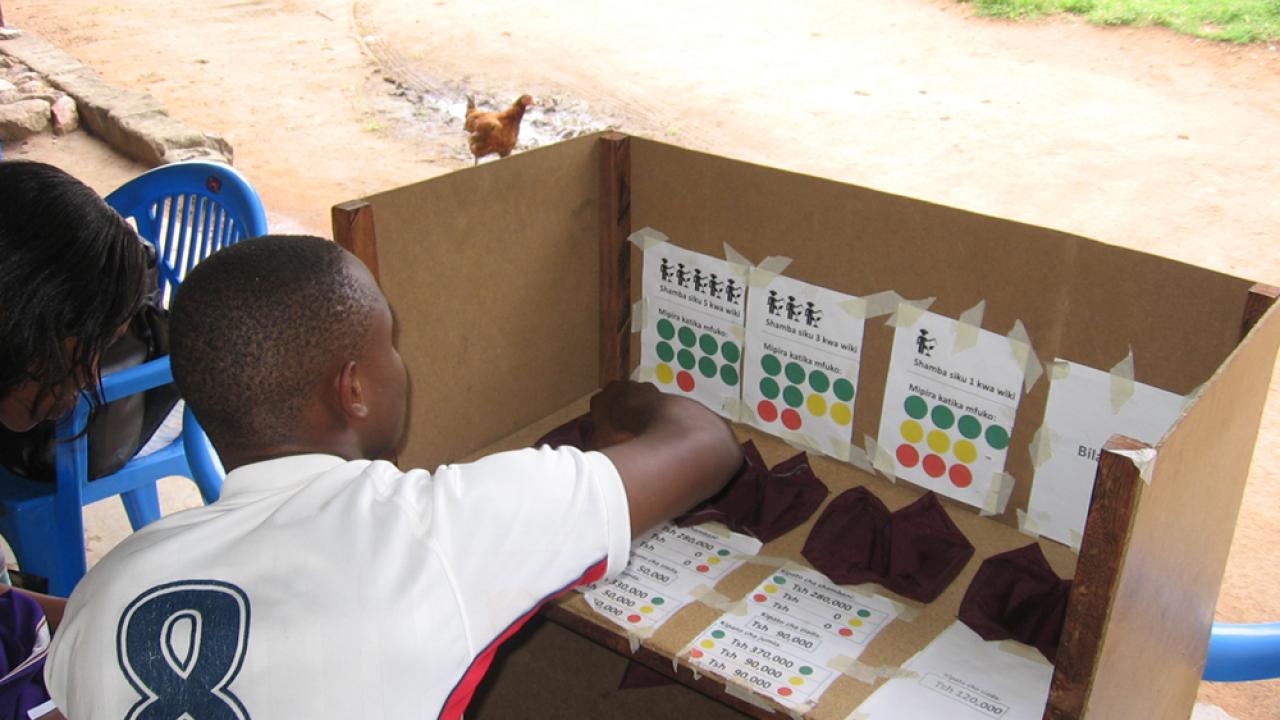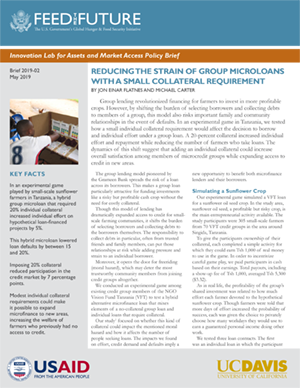
Group lending revolutionized financing for farmers to invest in more profitable crops. However, by shifting the burden of selecting borrowers and collecting debts to members of a group, this model also risks important family and community relationships in the event of defaults.
In an experimental game in Tanzania, we tested how a small individual collateral requirement would affect the decision to borrow and individual effort under a group loan. A 20-percent collateral increased individual effort and repayment while reducing the number of farmers who choose to borrow. The dynamics of this shift suggest that adding an individual collateral could increase overall satisfaction among members of microcredit groups while expanding access to credit in new areas.
Highlights
- In an experimental game played by small-scale sunflower farmers in Tanzania, a hybrid group microloan that required 20% individual collateral increased individual effort on hypothetical loan-financed projects by 5%.
- This hybrid microloan lowered loan defaults by between 15 and 20%.
- Imposing 20% collateral reduced participation in the credit market by 7 percentage points.
- Modest individual collateral requirements could make it possible to expand microfinance to new areas, increasing the welfare of farmers who previously had no access to credit.
The group lending model pioneered by the Grameen Bank spreads the risk of a loan across its borrowers. This makes a group loan particularly attractive for funding investments like a risky but profitable cash crop without the need for costly collateral.
Though this model of lending has dramatically expanded access to credit for small-scale farming communities, it shifts the burden of selecting borrowers and collecting debts to the borrowers themselves. The responsibility to collect debts in particular, often from trusted friends and family members, can put those relationships at risk while adding pressure and strain to an individual borrower.
Moreover, it opens the door for freeriding (moral hazard), which may deter the most trustworthy community members from joining credit groups altogether. We conducted an experimental game among existing credit group members of the NGO Vision Fund Tanzania (VFT) to test a hybrid alternative microfinance loan that mixes elements of a no-collateral group loan and individual loans that require collateral.
Our study[1] focused on whether this kind of collateral could impact the mentioned moral hazard and how it affects the number of people seeking loans. The impacts we found on effort, credit demand and defaults imply a new opportunity to benefit both microfinance lenders and their borrowers.
Simulating a Sunflower Crop
 Our experimental game simulated a VFT loan for a sunflower oil seed crop. In the study area, sunflower oil seed, a profitable but risky crop, is the main entrepreneurial activity available. The study participants were 305 small-scale farmers from 70 VFT credit groups in the area around Singida, Tanzania.
Our experimental game simulated a VFT loan for a sunflower oil seed crop. In the study area, sunflower oil seed, a profitable but risky crop, is the main entrepreneurial activity available. The study participants were 305 small-scale farmers from 70 VFT credit groups in the area around Singida, Tanzania.
To give the participants ownership of their collateral, each completed a simple activity for which they could earn Tsh 1,000 of real money to use in the game. In order to incentivize careful game play, we paid participants in cash based on their earnings. Total payouts, including a show-up fee of Tsh 1,000, averaged Tsh 5,300 ($3.32).
As in real life, the profitability of the group’s shared investment was related to how much effort each farmer devoted to the hypothetical sunflower crop. Though farmers were told that more days of effort increased the probability of success, each was given the choice to privately choose how many workdays they would use to earn a guaranteed personal income doing other work.
We tested three loan contracts. The first was an individual loan in which the participant simply chose whether or not to borrow and how much effort to devote to sunflowers. The second was a standard group loan in which a participant who decided to borrow was paired with two or three other participants, then privately chose their level of effort.
The third contract, a hybrid of individual and joint-liability loans, added individual collateral of 20 percent of her share of the group loan. All three contracts included dynamic incentives, meaning that defaulting borrowers (or groups for the joint liability contracts) were barred from borrowing in future rounds of the game.
Credit Demand, Effort and Repayment
Demand for credit was sensitive both to the type of loan, with a clear preference for an individual loan, and the requirement for collateral. Shifting from an individual to a group loan lowered demand for credit by 11 percentage points. Adding individual collateral to the group loan further reduced demand by 7 percentage points.
Adding the small collateral requirement to group loans significantly increased individual effort in the shared sunflower crop. Collateral increased effort by about 5 percent, or 0.20 workday. In comparison, moving from individual liability to joint liability increased effort by 3 percent, and this effect does not rely on farmers being socially connected to others in their group.
Imposing the small individual collateral requirement on its own reduced loan defaults by between 15 and 20 percent. A small part of this increase in repayments results from the fact that the collateral itself offsets some of the losses even if a group completely fails to pay back the loan. However, the majority of the impact was due to the increase in effort. This is one way that a collateral requirement reduces the portfolio at risk in microlending.
Increasing Access to Credit
Since the 1970s, experimental games like this one in Tanzania have proven a valuable tool for understanding how people make decisions. The body of research they have built provide valuable policy insights, in this case on how adding a small collateral requirement can benefit both microfinance lenders and small-scale farmer groups who use the loans to invest for higher incomes. Our results have several important implications, both for the welfare of small-scale farmers and for microfinance lenders.
First, microfinance lenders can introduce small collateral requirements to reduce defaults and expand the reach of their programs. This is particularly true in areas where people can afford a small collateral amount. The prospect of reducing defaults may even make it more feasible for lenders to expand into new areas, thus increasing the welfare of farmers who previously had no access to credit.
In our experiment, we made loan interest rates static, though in the real world higher rates of repayments should have the impact of reducing interest rates. This would be especially true if an influx of lenders in the area increased competition for borrowers. Lower interest rates would increase demand for credit among small-scale farmers and, with a lower cost to loans, further increase their income and welfare.
Our experiment is a first look at how this hybrid microloan would impact lending groups. In practice, this type of loan requires testing in the field. For example, we experimented with collateral at 20 percent, but in a real-world setting we don’t know yet exactly what level of collateral would keep loans within reach while also producing the increase in individual effort. Future testing in the field can help us to fine-tune these features for the best possible hybrid microloan product.
Jon Einar Flatnes is an assistant professor of agricultural, environmental, and development economics at The Ohio State University.
Michael Carter is a professor of agricultural and resource economics at UC Davis and director of the AMA Innovation Lab.
[1] Flatnes, J. et al. Forthcoming. “A little skin in the game: reducing moral hazard in joint liability lending through a mandatory collateral requirement.” Journal of Economic Behavior and Organization.
This report is made possible by the generous support of the American people through the United States Agency for International Development (USAID). The contents are the responsibility of the Feed the Future Innovation Lab for Assets and Market Access and do not necessarily reflect the views of USAID or the United States Government.
